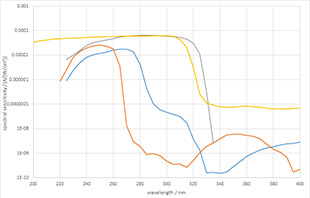VI.3. UV-Disinfection and Lamp Control
UV radiation can have harmful effects on human skin and eyes, especially during indoor application of high-energy UV irradiators. There is however a positive aspect to UV's hazardous effect on living organisms. Ultraviolet treatment of drinking and wastewater is a well-established, economical and efficient method for killing germs, bacteria, mold and fungus. Its use is becoming more widespread than traditional water treatment techniques employing chlorine and ozone for reasons of cost and environmental factors.
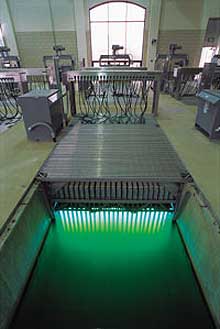
Fig. VI.11. UV treatment of wastewater
Recently, a field study performed in homeless shelters in New York, Birmingham and New Orleans (TB UV Shelter Study, TUSS) has shown that UV treatment of room air with upper room irradiators leads to a drastic reduction of tuberculosis infection rate.
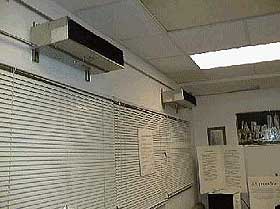
Fig.VI.12. Upper room UV irradiators help lower tuberculosis infection rates.
The CIE divides ultraviolet optical radiation into three ranges:
UV-A: 315 to 400 nm (skin pigmentation)
UV-B: 280 to 315 nm (vitamin D synthesis, erythema)
UV-C: 200 to 280 nm (germicidal action, absorption maximum of DNA). Below 230 nm, UV radiation has enough energy to break chemical bonds.
Short wavelength high energy ultraviolet radiation in the UV-C spectral range from 100 to 280 nm is used in the germicidal/bactericidal sterilization of air and water. UV-C at 253.7 nm is also employed in eprom erasure and the cleaning of sensitive surfaces in the semiconductor industry. UV curing is another area where UV-C is applied.
UV-C Light Sources Due to its high and pre-dominantly monochromatic output at 253.7 nm, low pressure mercury is the light source of choice in these applications. Medium and high pressure Hg as well as metal halide and other broadband UV sources are also used, especially in UV curing.
Light Source Life-time
The useful lifetime of high power UV-C sources is limited. UV-C intensity must be monitored to ensure process control.
Fighting Covid-19 With UVGI?
Yes, using ultraviolet optical radiation works to neutralize viruses and bacteria. However, not all UV disinfecting devices are effective. So how do you ensure your UV radiometer is qualified to provide accurate lamp efficacy measurements as well as proper assessment of UV hazard according to published safety guidelines?
Do you know what you need to know about UV-C Radiometers? Find out here.
UVC Germicidal Lamps
Irradiance & Dose Measurement Selection Criteria
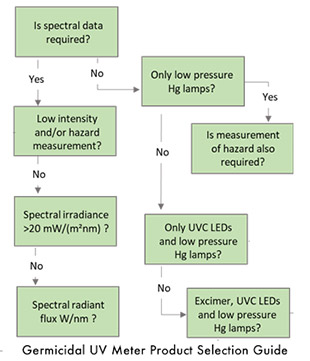 See the UV Radiometers and UV Spectroradiometers Recommendations for Germicidal Irradiance Devices.
See the UV Radiometers and UV Spectroradiometers Recommendations for Germicidal Irradiance Devices. 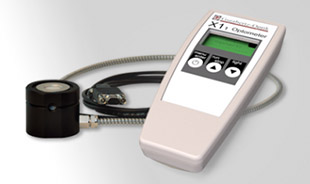
Gigahertz-Optik's UV radiometers are available in two different technologies:
- Broadband UV radiometers are most suited for routine measurements of the UV irradiance from known source types. They are inexpensive and very easy to use.
- UV spectroradiometers are ideal for research work and product development. They provide greatest radiometric accuracy independent of the source type.
- Download the UV Measurement Solutions Brochure here.

